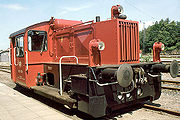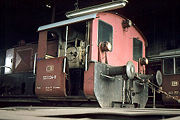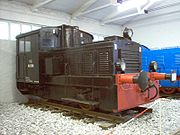
DRG Kleinlokomotive Class II
Encyclopedia


Kleinlokomotive
A Kleinlokomotive or Kleinlok is a German locomotive of small size and low power for light shunting duties at railway stations and on industrial railways. It is usually powered by a diesel engine...
n (literally: small locomotives) like the DRG Kö II (later: Köf II) were developed as locomotive
Locomotive
A locomotive is a railway vehicle that provides the motive power for a train. The word originates from the Latin loco – "from a place", ablative of locus, "place" + Medieval Latin motivus, "causing motion", and is a shortened form of the term locomotive engine, first used in the early 19th...
s with a low weight and driving power for light shunting duties. There were two classes, based on engine power. The Class II were engines which developed more than 40 (later 50) PS.
After tests with several trial locomotives, they were placed in service from 1932 onwards by the Deutsche Reichsbahn
Deutsche Reichsbahn-Gesellschaft
The Deutsche Reichsbahn – was the name of the German national railway created from the railways of the individual states of the German Empire following the end of World War I....
(DRG) and used on small stations for light shunting and marshalling work. They were intended to make the handling of goods traffic more economical. To do that an appropriately-trained controller had to be able to handle shunting duties using the locomotive. Accordingly the locomotive was designed to be robust and easy to operate.
Technology
Light locomotives mainly used diesel motors (originally classified as Kö/Köf/Köe by the DRG), as their source of energy, but there were also versions with BenzolBenzol
Benzol may refer to* Benzole* Benzene* Phenol* British Benzol, which was one of the largest independent oil distributors in the UK. It went into administration on 16 August 2005...
Gear
A gear is a rotating machine part having cut teeth, or cogs, which mesh with another toothed part in order to transmit torque. Two or more gears working in tandem are called a transmission and can produce a mechanical advantage through a gear ratio and thus may be considered a simple machine....
system. An f stood for an hydraulic drive and an e for electric traction motors, that were fed by a generator. Köf, therefore, stood for a light locomotive (Kleinlok) with diesel (Öl-(Diesel-)Motor) engine and hydraulic transmission (Flüssigkeitsgetriebe).
The locomotive is very small and of standard gauge size, but only fills about half the loading gauge profile. As a result, it can be loaded onto flat wagons
Flatcar
A flatcar is a piece of railroad or railway rolling stock that consists of an open, flat deck on four or six wheels or a pair of trucks or bogies . The deck of the car can be wood or steel, and the sides of the deck can include pockets for stakes or tie-down points to secure loads...
. That was necessary, because if it had to move under its own power, its top speed of only 30 km/h would have seriously held up rail traffic. It is driven by a diesel engine
Diesel engine
A diesel engine is an internal combustion engine that uses the heat of compression to initiate ignition to burn the fuel, which is injected into the combustion chamber...
, that works through a mechanical gear transmission system and dry clutch. Power is transmitted to the axles using a chain linkage.
The light diesel locomotives were the first German diesel engines that were built in batches by several manufacturers.
They were initially divided into two power groups:
- Class I (initially 40, later 50 PS)
- Class II (up to 90 PS)

The DB later developed a Köf III
DB Class Köf III
The DB railways Köf III class are light two axle shunting locomotives of Deutsche Bahn AG.-History:...
with up to 240 PS. In 1987, the Class 260/261 (up to 1968 called V 60) engines were classified as light locomotives.
The brake effort of the Kö was initially only the weight of the engine driver and the maximum force he could transmit via the brake pedal. With the introduction of new, more powerful motors (up to 128 PS) and the corresponding increase in tractive effort this proved far too little; as a result many light locos in the DB and DR were equipped with a compressed-air brake, that could also operated the brakes of attached wagons. In the DB the permitted top speed was raised from 30 to 45 km/h where compressed-air brakes had been installed. These locos can be easily recognised by their air reservoirs on the front. Because the open cab gave no real protection from the weather in winter, these were added during the course of main inspections from the late 1950s.
Classifications
Deutsche Reichsbahn-Gesellschaft: power category (Leistungsgruppe) II, Kb/Kö/Köf/Kbf 4001 to 6047Deutsche Bundesbahn: continued production of Köf II up to Köf 6835
Deutsche Bundesbahn: in 1968 redesignated as Class 321-324
Deutsche Reichsbahn (East Germany): new models Kö 4002 to 4032
Deutsche Reichsbahn (East Germany): in 1970 redesignated as Class 100
Deutsche Reichsbahn (East Germany): in 1973, narrow gauge Kö redesignated as Class 199
Deutsche Bahn AG: in 1992 DR Class 100 redesignated as DBAG Class 310
- Class 321: Vmax = 30 km/h, foot brake, rebuilt into 322-324 stopped in February 1974
- Class 322: Vmax = 30 km/h, compressed-air brake
- Class 323-324: Vmax = 45 km/h, compressed-air brake
Deutsche Bundesbahn/Deutsche Bahn AG
In the 1980s numerous Köf IIs were still in service with the DB and DR (some over 50 years old. For a while, DB 323 412 and 323 415 were the oldest locomotives in the Deutsche Bundesbahn), as well as a handful of battery-operated light locos, of classes 381 and 382. Since 1999 no Köf IIs have worked for the Deutsche Bahn AG. However many remain working for other railway companies and societies, both in regular services and as museum locomotives.East German Deutsche Reichsbahn
In 1970 the Deutsche Reichsbahn incorporated 378 machines of power category 2 in its EDPElectronic data processing
Electronic Data Processing can refer to the use of automated methods to process commercial data. Typically, this uses relatively simple, repetitive activities to process large volumes of similar information...
classification scheme as Class 100. After German reunification
German reunification
German reunification was the process in 1990 in which the German Democratic Republic joined the Federal Republic of Germany , and when Berlin reunited into a single city, as provided by its then Grundgesetz constitution Article 23. The start of this process is commonly referred by Germans as die...
these became Class 310 in the DB AG. Only a few of the DR's light locomotives had hydraulic power transmission; they were grouped into sub-class 100.8. Under the old numbering scheme they were classified as Köf. Dead man's handles (Sifa) and radios for marshalling were not common. The Deutsche Reichsbahn converted many Kö to compressed-air brakes, this programme had not been completed when the Berlin Wall
Berlin Wall
The Berlin Wall was a barrier constructed by the German Democratic Republic starting on 13 August 1961, that completely cut off West Berlin from surrounding East Germany and from East Berlin...
came down.
In 1983/84 three DR Kö II were converted to metre gauge
Metre gauge
Metre gauge refers to narrow gauge railways and tramways with a track gauge of . In some African, American and Asian countries it is the main gauge. In Europe it has been used for local railways in France, Germany, and Belgium, most of which were closed down in mid 20th century. Only in Switzerland...
working for the Halle industrial railway and the Harz Narrow Gauge Railway. They have been preserved.
See also
- Deutsche ReichsbahnDeutsche ReichsbahnDeutsche Reichsbahn was the name of the following two companies:* Deutsche Reichsbahn, the German Imperial Railways during the Weimar Republic, the Third Reich and the immediate aftermath...
- List of DRG locomotives and railbuses
- KleinlokomotiveKleinlokomotiveA Kleinlokomotive or Kleinlok is a German locomotive of small size and low power for light shunting duties at railway stations and on industrial railways. It is usually powered by a diesel engine...
- DRG Kleinlokomotive Class IDRG Kleinlokomotive Class IThe Kleinlokomotiven of Class I were light German locomotives of low weight and power designed for shunting duties. They were placed in service by the Deutsche Reichsbahn after trials had been carried out on several prototype locomotives in 1930...
- DB Class Köf IIIDB Class Köf IIIThe DB railways Köf III class are light two axle shunting locomotives of Deutsche Bahn AG.-History:...
Literature
- Peter Große, Horst Troche: Die Einheitskleinlokomotiven Leistungsgruppen I und II EK-Verlag Freiburg 2002 ISBN 3-88255-217-4
External links
- Deutsche Kleinloks.de, Extensive data bank for all Köf (German)
- Axel Klatt's light locomotive pages (German)
- kleinlok.de
- There is a relevant English-language forum at Railways of Germany

